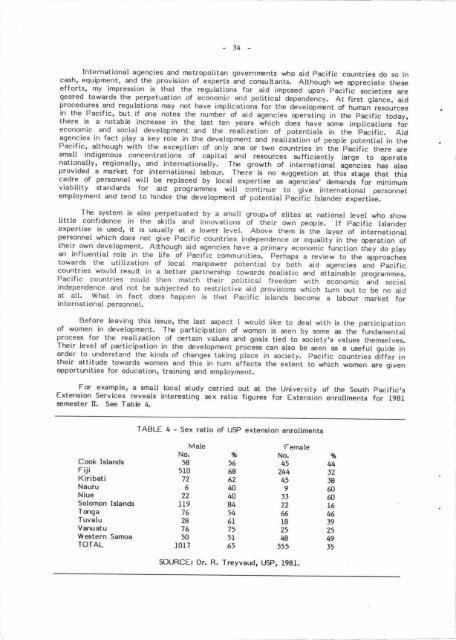Rt€@lll
Rt€@lll
Rt€@lll
You also want an ePaper? Increase the reach of your titles
YUMPU automatically turns print PDFs into web optimized ePapers that Google loves.
-t4<br />
International agencies and nreLropolitan governnents who aid Pecific countries do so in<br />
cash' equipment, and lhe provision of experLs and consultants. Although we appreciate these<br />
efforts, my impression is that the regulations for aid imposed upori pacific societies are<br />
geared towards the perpetuation of economic and political dependency. At finst glance, aid<br />
procedules and regulations may not have implicaLions for the development of human resources<br />
in the Pacific, but if one notes the number of aid agencies op"rating in the pacific today,<br />
there is a notable increase in the last ten years wfricn does have- some implications for<br />
economic and social developnrent and the realization of potentials in the pecific. Aid<br />
agencies in fact play a key role in the development and realization of people pot,ential in Lhe<br />
Pacific' although with the exception of only one or two countries in'the pacific there are<br />
small indigenous concentrations of capital and resources suff iciently large to qerate<br />
nationally' regionally, and internationally. The growth of international agencies has also<br />
provided a market for international labour. There is no zuggestion at thij stage that this<br />
cadre of personnel will be replaced by loeal expertise as ilencies' demands for minimum<br />
viability standards . for aid programmes will continue to give international personnel<br />
employment and tend to hinder the developnenl of potential pacific Islander expertise.<br />
The system is also perpetuated by a srnall group' of elites at national level who show<br />
little confidence in the skills and innovetions of [heir own people. If pacific Islander<br />
expertise is used, it is usually at a lower level. Above them is the layer of international<br />
personnel which does not give Pacifie countries independenee or equality in the operation of<br />
their own development. Although aid agencies have a primary economic iunction they do play<br />
an influential role in the life of Pacific communities. Perhaps a review to the approaches<br />
towards the utilization of local manpower potential by both aid agencies and pacif ic<br />
countries would result in a betten partnenship towards realistic and att-ainable programmes.<br />
Pacif ic countries could then match their political freedom with economie ' anl social<br />
independence and not be zubjeeted to reslrictive aid provisions which turn ou! to be no aid<br />
at all. What in fact does happen is that Pacif ic islands become a labour market for<br />
internati onal personnel.<br />
Before leaving this issue, the last aspect I would like to deal with is the participation<br />
of women in developmenL. The participation of women is seen by some as the fundamental<br />
Proeess for the realization of certain values and goals tied to society's values themselves.<br />
Their level of participation in the development process can also be seen a{r a useful guide in<br />
order [o understand the kinds of changes taking place in society. Pacific countries differ in<br />
their attitude towards women and this in turn affects the extent to which women are given<br />
opportunities for edueation, [raining and employment.<br />
For example, a small local study carried out at the University of the South pacific's<br />
Extension Services reveels interesting sex ratio figures for Extension enrollments for Iggl<br />
semester II. See Table 4.<br />
Cook Islands<br />
Fiji<br />
Kiribati<br />
Nauru<br />
Niue<br />
Solomon Islands<br />
Tmga<br />
Tuvalu<br />
Vanuetu<br />
Weatern Samoa<br />
TOTAL<br />
TAB|I 4 - Sex ratio of USP extension enrollmentg<br />
Male<br />
No.<br />
58<br />
510<br />
72<br />
6<br />
22<br />
tI9<br />
76<br />
28<br />
76<br />
50<br />
tol7<br />
Vo<br />
56<br />
68<br />
62<br />
40<br />
40<br />
84<br />
54<br />
6t<br />
75<br />
5L<br />
65<br />
Female<br />
No.<br />
45<br />
244<br />
45<br />
9<br />
tt<br />
22<br />
66<br />
l8<br />
25<br />
48<br />
555<br />
SOURCE: Dr. R. Treyvaud, USP, l98l.<br />
%<br />
tt4<br />
,2<br />
5g<br />
6u<br />
60<br />
t6<br />
46<br />
t9<br />
25<br />
49<br />
,5














![R]€@lll](https://img.yumpu.com/7594335/1/175x260/reurlll.jpg?quality=85)
